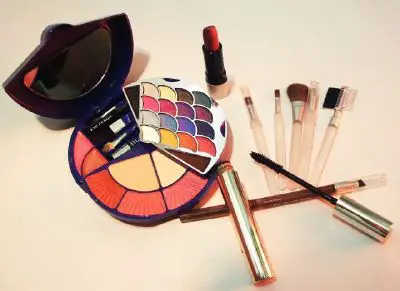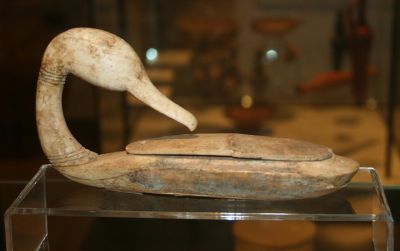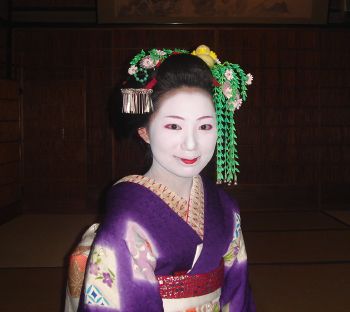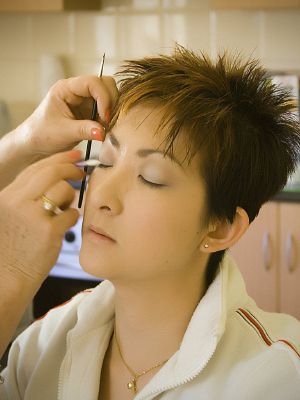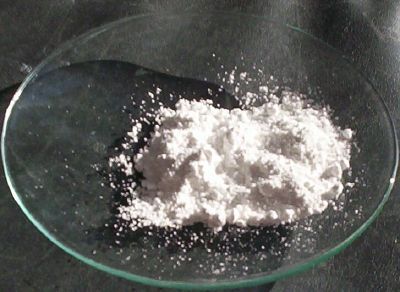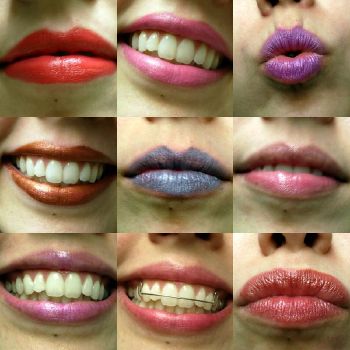Cosmetics
Cosmetics are substances used to enhance or protect the appearance or odor of the human body. They include skin-care creams, lotions, powders, perfumes, lipsticks, fingernail and toenail polishes, eye and facial makeup, permanent waves, hair colors, hair sprays and gels, deodorants, baby products, bath oils, bubble baths, bath salts, butters and many other types of products. Their use is widespread, especially among women in Western countries. A subset of cosmetics is called "makeup," which refers primarily to colored products intended to alter the user’s appearance.
The U.S. Food and Drug Administration (FDA), which regulates cosmetics in the United States, defines cosmetics as products "intended to be applied to the human body for cleansing, beautifying, promoting attractiveness, or altering the appearance without affecting the body's structure or functions."[1] This broad definition includes any material intended for use as a component of a cosmetic product. The FDA specifically excludes soap from this particular category.[1]
History
The history of cosmetics spans at least 6,000 years of human history, and almost every society on earth. In the Western world, the use of cosmetics became prominent in the Middle Ages, typically among members of the upper classes.
Cosmetic use was frowned upon at some points in history. For example, in the nineteenth century, makeup was used primarily by prostitutes, and Queen Victoria publicly declared makeup improper, vulgar, and acceptable for use by actors only.[2] Adolf Hitler told women that face painting was for clowns and not for the women of the Master Race.
By the middle of the twentieth century, cosmetics were in widespread use in nearly all societies around the world.
Ancient Egypt, Greece, and Rome
The first archaeological evidence of cosmetics usage is found in Ancient Egypt around 4000 B.C.E. The Ancient Greeks and Romans also used cosmetics. The Romans and Ancient Egyptians used cosmetics containing mercury and white lead, unaware of their toxicity.[2]
Africa
The cosmetic uses of kohl and henna appear to have their roots in northern Africa.
The Middle East
Cosmetics were used in Persia and what is today the Middle East from ancient periods. The biblical book of Esther describes various beauty treatments. In addition, fragrances, particularly frankincense and myrrh are mentioned in the book of Exodus (Exodus 30:34) and the Gospel of Matthew (Matthew 2:11).
After Arab tribes converted to Islam and conquered various parts of the Middle East, cosmetics were restricted in some areas only if they were to disguise the real look in order to mislead or cause uncontrolled desire. On the other hand, some fundamentalist branches of Islam forbade the use of cosmetics.
An early cosmetologist was the physician Abu’al-Qassim al-Zahrawi, or Abulcassis (936-1013 C.E.), who wrote the 30-volume medical encyclopedia Al-Tasrif. A chapter of the nineteenth volume was devoted to cosmetics. As the treatise was translated into Latin, the cosmetic chapter was used in the West. Al-Zahrawi considered cosmetics a branch of medicine, which he called Medicine of Beauty (Adwiyat al-Zinah). He wrote about perfumes, scented aromatics, and incense. There were perfumed stocks rolled and pressed in special molds, perhaps the earliest antecedents of present-day lipsticks and solid deodorants. He used oily substances called Adhan for medication and beautification.[3]
South Asia
Henna has been used in India since around the fourth or fifth centuries. It is used either as a hair dye or in the art of mehndi, in which complex designs are painted on the hands and feet, especially during auspicious occasions such as a Hindu wedding. Henna is also used in some north African cultures.
The use of kohl (or kajal) has a long history in Hindu culture. Traditional preparations of kohl on children and adults have been thought to have health benefits, but in the United States, it has been linked to lead poisoning and is prohibited.[4]
China
Chinese people began to stain their fingernails with gum arabic, gelatin, beeswax and egg from around 3000 B.C.E. The colors represented social class: Chou dynasty royals wore gold and silver; later royals wore black or red. The lower classes were forbidden to wear bright colors on their nails.
Japan
In Japan, geishas wore lipstick made of crushed safflower petals to paint the eyebrows and edges of the eyes as well as the lips. Sticks of bintsuke wax, a softer version of the sumo wrestlers' hair wax, were used by geisha as a makeup base. Rice powder colors the face and back; rouge contours the eye socket and defines the nose. Ohaguro (black paint) colors the teeth for the ceremony when maiko (apprentice geisha) graduate and become independent.
Europe
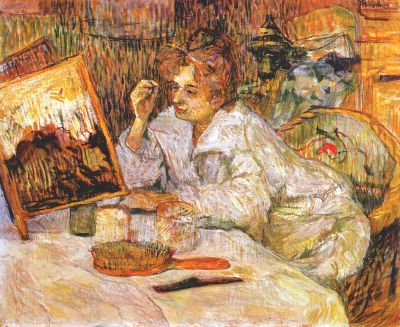
During the Middle Ages, Renaissance, and up until the Industrial Revolution, the lower classes had to work outdoors, in agricultural jobs. The typically light-colored European skin was darkened by exposure to the Sun. The higher class a person was, the more leisure time he or she had to spend indoors, which kept the skin pale. Thus, people in the highest classes of European society, able to spend all their time protected from the Sun, frequently had the lightest-looking skin. As a result, European men and women often attempted to lighten their skin directly, or used white powder on their skin to look more aristocratic. A variety of products were used, including white lead paint that, as if the toxic lead wasn't bad enough, notoriously also contained arsenic.
The Americas
Some Native American tribes painted their faces for ceremonial events or battle.
The twentieth century
During the early years of the twentieth century, makeup became fashionable in the United States of America and Europe, partly because of the influence of ballet and theater stars such as Mathilde Kschessinska and Sarah Bernhardt. But the most influential new development was that of the movie industry in Hollywood. Among those who saw the opportunity for mass-market cosmetics were Max Factor, Sr., Elizabeth Arden, and Helena Rubinstein. Modern synthetic hair dye was invented in 1907 by Eugene Schueller, founder of L'Oréal. He also invented sunscreen in 1936.
The flapper look came into fashion in the 1920s, promoting dark eyes, red lipstick, red nail polish, and the suntan, invented as a fashion statement by Coco Chanel. Earlier, suntans had been sported only by agricultural workers, while fashionable women kept their skins as pale as possible. In the wake of Chanel's adoption of the suntan, dozens of new fake tan products were produced to help both men and women achieve the "sun-kissed" look. In Asia, skin whitening continued to represent the ideal of beauty.
Industry Today
The manufacture of cosmetics is currently dominated by a small number of multinational corporations that originated in the early twentieth century, but the distribution and sale of cosmetics is spread among a wide range of different businesses.
Of the major firms, the oldest and the largest is L'Oréal, which was founded by Eugene Schueller in 1909 as the French Harmless Hair Colouring Company. The market was developed in the United States during the 1910s by Elizabeth Arden, Helena Rubinstein, and Max Factor. These firms were joined by Revlon just before World War II and Estée Lauder just after.
Types
The various forms of makeup include:
- Lipstick, lip gloss, lip liner, lip plumper, lip balm, lip luster, lip conditioner and lip boosters.
- Foundation, used to color the face and conceal flaws to produce an impression of health and youth. Usually a liquid, cream, powder, or mousse.
- Powder, or face illuminator used to set the foundation, giving a matte finish.
- Rouge, blush or blusher, cheek stain used to color the cheeks and emphasize the cheekbones. This comes in powder, cream and gel forms.
- Bronzer, used to create a more tanned or sun-kissed look.
- Mascara and lash extender, lash conditioner used to enhance the eyelashes. Can be of different colors and even waterproof.
- Eye liner and eye shadow, eye shimmer and glitter eye pencils as well as different color pencils used to color and emphasize the eyelids (larger eyes are a sign of youth).
- Eyebrow pencils, creams, waxes, gels and powders are used to fill in and define the brows.
- Nail polish, used to color the fingernails and toenails.
- Concealer, a type of thick opaque makeup used to cover pimples, various spots and inconsistencies in the skin.
Also included in the general category of cosmetics are skin care products. These include creams and lotions to moisturize the face and body, sunscreens to protect the skin from damaging UV radiation, and treatment products to repair or hide skin imperfections (acne, wrinkles, dark circles under eyes, etc.).
Cosmetics can also be described by the form of the product, as well as the area for application.
Cosmetics can be liquid or cream emulsions; powders, both pressed and loose; dispersions; and anhydrous creams or sticks.
Special Effects
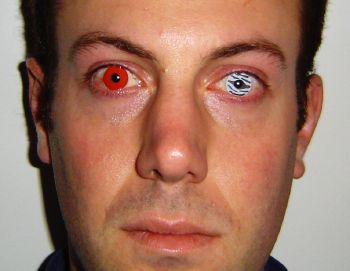
In addition to over-the-counter cosmetic products, recent years have seen an increasing market for prescription or surgical cosmetic procedures. These range from temporary enhancements, such as cosmetic colored contact lenses, to major cosmetic surgery.
Many techniques, such as microdermabrasion and chemical or physical peels, remove the oldest, top layers of skin cells. The younger layers of skin left behind appear more plump, youthful, and soft. Permanent application of pigments (tattooing) is also used cosmetically.
Ingredients
While there is assurance from the largest cosmetic companies that their various ingredients are safe, there is a growing preference for cosmetics that are without any "synthetic" ingredients, especially those derived from petroleum. Once a niche market, certified organic products are becoming more mainstream.
Ingredients' listings in cosmetics are highly regulated in many countries. The testing of cosmetic products on animals is a subject of some controversy. It is now illegal in the United Kingdom, the Netherlands, and Belgium, and a ban across the European Union is due to come into effect in 2009.
Cosmetics ingredients come from a variety of sources but, unlike the ingredients of food, are often not considered by most consumers. Cosmetics often use vibrant colors that are derived from some unexpected sources, ranging from crushed insects to rust. Many new techniques have allowed manufacturers to synthesize such colors and the use of animals (or parts thereof) has been declining for many years.
Cosmetics in a variety of forms date back to early civilizations, with the need to improve ones personal appearance being an important factor in attracting a mate. Over the years, the ingredients have changed dramatically as we discovered how to manufacture our own scents and cosmetic formulae. The realization of the dangers of many common ingredients also greatly impacted the growing industry.
Ancient Egyptian aristocracy made use of minerals to provide color and definition to their facial features. During the era of the Greek Empire, it was common to use face paints, while the Romans indulged in baths containing oil-based perfume.
Common ingredients
Clay is one of the most common ingredients found to benefit the skin, possibly due to the minerals that are released.[5]It was reported that Cleopatra used mineral-rich black muds from the Dead Sea.
Castor oil and its derivatives are found in many cosmetics as it is "non-comedogenic" (does not exacerbate or contribute to acne).[6]
Cerebrosides (cells from the nervous systems of cattle or swine) were once used in some high-end skin-care products to increase moisture retention and to create a smooth skin surface.[7] However, the Bovine Spongiform Encephalopathy (BSE) ("mad cow" disease) controversy put an end to this practice.
Visual effects
Strong red colors for eye products have been produced using the dye carmine, made from carminic acid extracted from the crushed bodies of the cochineal insect. Carmine was once the only bright red color permitted by the FDA for use around the eye.
Pearlescence (sometimes spelt "pearl essence") is a shine or gloss effect commonly used in a wide variety of cosmetic products. The most usual source of pearlescence is the natural mineral mica covered by a thin layer of titanium dioxide. This coating causes goniochromism – the color appears through interference effects with the naturally translucent mica, and varying the thickness of the titanium dioxide changes the color. Alternatives exist, including the suspension of tiny flakes of a suitable material within the product, often a wax such as glycol distearate. A shimmery substance found on fish scales, most usually obtained from herring and one of many by-products of commercial fish processing, can also be used for pearlescent effects, primarily in nail polish, but is now rarely used due to its high cost, bismuth oxychloride flakes being used as a substitute instead.[8]
Types of cosmetics
Facial cosmetics
Foundation
Foundation is a cream, liquid, mousse, or powder product applied to the entirety of the face to create a smooth and even base in the user's skin tone. Foundation provides a generally lower amount of coverage than concealer, and is sold in formulations that can provide sheer, matte, dewy, or full coverage to the skin. Women of Roman Britain are reported to have used a tin-based foundation to get a pale and appealing look.[9]
Lipstick
Lipstick is known to have been used around 5000 years ago in ancient Babylon, when semi-precious jewels were crushed and applied to the lips and occasionally around the eyes. Ancient Egyptians extracted purplish-red dye from fucus-algin, 0.01 percent iodine, and some bromine mannite, which resulted in serious illness. Cleopatra had her lipstick made from crushed carmine beetles, which gave a deep red pigment, and ants for a base.[2]
The red color of modern lipstick can come from synthetically derived pure iron oxide (one of the components of rust), however most leading brands use the more economical synthetic colors. In the United States, every batch of synthetic dye and pigment must have a sample sent to the U.S. FDA for testing and certification that the batch is pure and its contaminants are below the levels specified by law.[10] Synthetic colors are listed in the ingredients as a code (for example, F&D red no 6). There is some controversy over the presence of poisonous trace ingredients, especially since makeup worn on the lips is not just absorbed through the skin, but also swallowed with drinking and eating. Because lowering these levels would make the production and sale of practically all lipstick illegal, and because the FDA has determined that the existing levels are safe, the cosmetic industry continues to produce and sell lipstick.[11]
Typically, the pigment is crushed very finely (7 to 10 micrometers) while being mixed with castor oil and is then mixed with a wax base to form a finished lipstick.
Lipsticks may be sheer or dense, matte or shiny. In their thinnest and most fluid consistency, they are given their own category, lipgloss.
Perfume
Islamic cultures contributed significantly in the development of western perfumery in both perfecting the extraction of fragrances through steam distillation and introducing new, raw ingredients. Both of the raw ingredients and distillation technology significantly influenced western perfumery and scientific developments, particularly chemistry.[12]
As traders, Islamic cultures such as the Arabs and Persians had wider access to different spices, herbals, and other fragrance material. In addition to trading them, many of these exotic materials were cultivated by the Muslims such that they can be successfully grown outside of their native climates. Two examples of this include jasmine, which is native to South and Southeast Asia, and various citrus, which are native to East Asia. Both of these ingredients are still highly important in modern perfumery.[12]
The Crusaders brought alcohol-based perfumes back to Europe from the Middle East in the thirteenth century.[13]
The first modern perfume, made of scented oils blended in an alcohol solution, was made in 1370 at the command of the Queen of Hungary and was known throughout Europe as Hungary Water.[14] France quickly became the European center of perfume and cosmetic manufacture, cultivating vast amounts of flowers for their essence. By the eighteenth century, aromatic plants were being specifically grown in the Grasse region of France to provide the growing perfume industry with raw materials.[15]
Regulation
Legislation varies from country to country but most countries have some sort of formal legislation that either restrict or prohibit certain ingredients or products. There are two main sources for cosmetics safety: Regulation (EC) N° 1223/2009, which replaced the EU Cosmetics Directive 76/768/EEC[16] and the Canadian Cosmetic Ingredient Hotlist.[17]
Cosmetic colorants are highly regulated. In the United States, the regulating body is the Food and Drug Administration. Each country or group of countries has their own regulatory agency that controls what can go into cosmetics. Many colorants in cosmetics are also used as food dyes.
Popularity and criticism
The popularity of cosmetics increased rapidly in the twentieth century. Especially in the United States, cosmetics are used by girls at a younger and younger age. Many companies have catered to this expanding market by introducing more flavored lipsticks and glosses, cosmetics packaged in glittery, sparkly packaging and marketing and advertising using young models. The social consequences of younger and younger beautification has had much attention in the media over the last few years.
Criticism of cosmetics has come from a variety of sources, including feminists, animal rights activists, and public interest groups. There is a growing awareness and preference for cosmetics that are without any toxic ingredients, especially those derived from petroleum, SLS, and parabens.[18]
Notes
- ↑ 1.0 1.1 Summary of Cosmetics Labeling Requirements US Department of Health and Human Services. Retrieved January 17, 2023.
- ↑ 2.0 2.1 2.2 Rita Johnson, What's that Stuff? Chemical & Engineering News 77(28) (July 12,1999): 31. Retrieved January 17, 2023.
- ↑ Muslim Contribution to Cosmetics Muslim Heritage, May 20, 2003. Retrieved January 17, 2023.
- ↑ Kohl, Kajal, Al-Kahal, Surma, Tiro, Tozali, or Kwalli: By Any Name, Beware of Lead Poisoning U.S. Food and Drug Administration. Retrieved January 17, 2023.
- ↑ Guide to Types of Cosmetic Clay & Their Uses Mountain Rose Herbs. Retrieved January 17, 2023.
- ↑ Corinne O'Keefe Osborn, Can You Use Castor Oil on Your Face? HealthLine, November 14, 2018. Retrieved January 17, 2023.
- ↑ Ceramides Cosmetic Obs, November 29, 2016. Retrieved January 17, 2023.
- ↑ Cecil Adams, Does lipstick contain fish scales? The Straight Dope, March 31, 2000. Retrieved January 17, 2023.
- ↑ Roman cosmetic secrets revealed BBC News, November 3, 2004. Retrieved January 17, 2022.
- ↑ Federal Food, Drug, and Cosmetic Act (FD&C Act) U.S. Food and Drug Administration. Retrieved January 17, 2023.
- ↑ Color Additives History U.S. Food and Drug Administration. Retrieved January 17, 2023.
- ↑ 12.0 12.1 Martin Levey, Early Arabic Pharmacology (Leiden, NL: E.J. Brill, 1973, ISBN 9004037969).
- ↑ A History of Cosmetics from Ancient Times Cosmetics Info. Retrieved January 17, 2023.
- ↑ The First Perfume – Hungary Water History of Perfume. Retrieved January 17, 2023.
- ↑ Eleanor Beardsley, In France's Perfume Capital Of The World, There's A World Of Beautiful Fragrance NPR, September 25, 2021. Retrieved January 17, 2023.
- ↑ Legislation Internal Market, Industry, Entrepreneurship and SMEs, European Commission. Retrieved January 17, 2023.
- ↑ Cosmetic Ingredient Hotlist Government of Canada. Retrieved January 17, 2023.
- ↑ About Us Campaign for Safe Cosmetics (CSC). Retrieved January 17, 2023.
ReferencesISBN links support NWE through referral fees
- Byers, Dorie. Natural Beauty Basics: Create Your Own Cosmetics and Body Care Products. Ridgefield CT: Vital Health Publishing, 2001. ISBN 1890612197
- Levey, Martin. Early Arabic Pharmacology. Leiden, NL: E.J. Brill, 1973. ISBN 9004037969
- Michalun, Natalia and Varinia Michalun. Skin Care and Cosmetic Ingredients Dictionary. (Delmar Cengage Learning) Clifton Park, NY: Milady, 2000. ISBN 1562536605
- Winter, Ruth. A Consumer's Dictionary of Cosmetic Ingredients: Complete Information About the Harmful and Desirable Ingredients in Cosmetics. New York, NY: Three Rivers Press/Random House, 2005. ISBN 1400052335
Credits
New World Encyclopedia writers and editors rewrote and completed the Wikipedia article in accordance with New World Encyclopedia standards. This article abides by terms of the Creative Commons CC-by-sa 3.0 License (CC-by-sa), which may be used and disseminated with proper attribution. Credit is due under the terms of this license that can reference both the New World Encyclopedia contributors and the selfless volunteer contributors of the Wikimedia Foundation. To cite this article click here for a list of acceptable citing formats.The history of earlier contributions by wikipedians is accessible to researchers here:
The history of this article since it was imported to New World Encyclopedia:
Note: Some restrictions may apply to use of individual images which are separately licensed.
